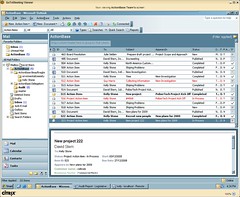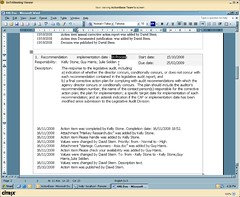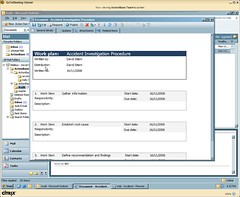I had a chance to meet up with ActionBase at one of the Gartner conferences last year, and recently had an in-depth demo to take a look at their new version. ActionBase focuses on the unstructured, human-centric processes that exist primarily within email today, outside of the more rigid processes codified within enterprise applications, and provides tools for adding a bit of structure while staying in the MS-Office environment. The goal is to allow users to create their own ad hoc processes without IT involvement: similar to what people are doing in email today, but with some nice hooks for assigning action items, and full tracking capabilities for the processes.
There are three key components involved:
 ActionMail aggregates all items/messages related to a process as a single line item in an ActionBase folder within Outlook. This acts as a single location where a user can see work in progress and completed processes, with common visual identifiers for overdue items (red) and items with new activities (bold). Each line item can correspond to multiple actions assigned to multiple people, plus their responses, which solves the problem of collecting together all of the emails related to a specific ad hoc process.
ActionMail aggregates all items/messages related to a process as a single line item in an ActionBase folder within Outlook. This acts as a single location where a user can see work in progress and completed processes, with common visual identifiers for overdue items (red) and items with new activities (bold). Each line item can correspond to multiple actions assigned to multiple people, plus their responses, which solves the problem of collecting together all of the emails related to a specific ad hoc process. - ActionDocs provides a templated document in Word for defining actions and follow-up items, with links to the Outlook address book for assigning activities. Processes are created and modified by editing the document.
- Behind the scenes, the process information is kept in a MS SQL Server database, which is used for tracking and reporting.
 The paradigm is interesting: a process that consists solely of human tasks (which is what ActionBase is addressing) is really just a big to-do list, where each item on the to-do list is assigned to one or more people, and may have a start and end (due) date assigned to it.
The paradigm is interesting: a process that consists solely of human tasks (which is what ActionBase is addressing) is really just a big to-do list, where each item on the to-do list is assigned to one or more people, and may have a start and end (due) date assigned to it.
To create a process in ActionBase, you simply create a Word document based on the ActionBase template. By default, there are sections for a few tasks (work items), and new tasks can be added using the menu items on the template toolbar directly in the Word document. Since the process is unstructured, there is no process flow or order for the tasks, although start and end dates can be specified for each task. That means that you can’t, for example, specify that task B can only start when task A is complete, or do any sort of branching or conditional logic. You can assign the tasks to anyone in your Outlook/Exchange global address list – including external addresses — and add anyone on the GAL to the distribution list to allow them to track the item even if they don’t have any tasks assigned to them.
 Once you’re done filling in the blanks in the document, you publish it, which saves everything to the backend database and kicks off the process. The document is sent to everyone on the distribution list, using a link for internal recipients and an attachment for external recipients; then, on the start date for each task, the assignees are sent a notification of the start of the task. Participants in the tasks can complete, forward, reject or respond to the task, and create addition items related to it. As their responses are added, anyone on the distribution list can see what’s happening by finding the process in the Outlook ActionBase folder, opening the process, then selecting the “Word Report” view to see the underlying document populated with the current state of each task from the database. If anyone has acted on a task in a process, the process will appear bold in everyone’s ActionBase folder in Outlook; if there are tasks past their due dates, it will turn red.
Once you’re done filling in the blanks in the document, you publish it, which saves everything to the backend database and kicks off the process. The document is sent to everyone on the distribution list, using a link for internal recipients and an attachment for external recipients; then, on the start date for each task, the assignees are sent a notification of the start of the task. Participants in the tasks can complete, forward, reject or respond to the task, and create addition items related to it. As their responses are added, anyone on the distribution list can see what’s happening by finding the process in the Outlook ActionBase folder, opening the process, then selecting the “Word Report” view to see the underlying document populated with the current state of each task from the database. If anyone has acted on a task in a process, the process will appear bold in everyone’s ActionBase folder in Outlook; if there are tasks past their due dates, it will turn red.
 For external participants, ProcessBridge allows external people to be included in ActionBase activities via email: they receive an email that has links built in for Respond/Complete/Reject responses. Since there’s some automation around handling these responses from outside Exchange, this can also be used to trigger processes based on inbound email to a shared email inbox (e.g., [email protected]), or exchange tasks and messages with other internal systems triggered by an email from that systems.
For external participants, ProcessBridge allows external people to be included in ActionBase activities via email: they receive an email that has links built in for Respond/Complete/Reject responses. Since there’s some automation around handling these responses from outside Exchange, this can also be used to trigger processes based on inbound email to a shared email inbox (e.g., [email protected]), or exchange tasks and messages with other internal systems triggered by an email from that systems.
They’re also using BackFlip’s infrastructure for responding to and delivering messages to mobile participants, allowing people to act on processes via SMS messages and through a simple WAP browser. Users can identify, by topic and priority, which events to receive via their mobile device.
 A new version of ActionBase to be released this quarter with better Outlook and Word integration. For example, there’s no need to create an ActionDocs document based on one of their templates; an ActionBase tab in Word 2008 allows a new action item to be created directly within any document, and viewed as an collapsible action item. That’s a big deal for many companies that have their own document templates and wouldn’t consider using ActionBase’s templates for all of their documents. They’re also considering integration with other Office applications: I see Excel as a perfect candidate for this since many people use it to organize multi-person to-do lists like this.
A new version of ActionBase to be released this quarter with better Outlook and Word integration. For example, there’s no need to create an ActionDocs document based on one of their templates; an ActionBase tab in Word 2008 allows a new action item to be created directly within any document, and viewed as an collapsible action item. That’s a big deal for many companies that have their own document templates and wouldn’t consider using ActionBase’s templates for all of their documents. They’re also considering integration with other Office applications: I see Excel as a perfect candidate for this since many people use it to organize multi-person to-do lists like this.
One key issue that I see is the need for Office 2007: many large enterprises that I work with are still on 2003, with no driving need to migrate to 2007. Although mainstream support for Office 2003 ends this year, Microsoft won’t be pulling the plug on extended support for that version until 2014.
Whenever I visit a large enterprise and take a look at their business processes, I see email being used for ad hoc processes everywhere. Some companies create their own standards for how that email is used for managing these processes, and may do an adequate job with a fair amount of manual overhead, but most of them tend to “fire and forget”, hoping that the required activities for that process will magically happen. Even when business processes are partially automated in BPM, CRM and ERP systems, there are almost always exceptions that can’t be handled adequately, and end up with items parked in those systems while someone sends off emails to try and resolve the issue. As soon as that happens, you lose the tracking capabilities and audit trail for that process until a response makes its way back into the systems.
“Human process management” solutions like ActionBase have the potential to fill in the gaps between full BPM systems and the chaos of unmanaged email-based processes. There are other collaboration tools that could fill the same purpose but have quite different functionality – even SharePoint could do a lot of this type of collaborative human process management, just not email-based – so I think that their biggest challenge will be finding the right positioning.
Update: ActionBase held a webinar last week, which I missed because of some problem with the web conferencing software (apparently I wasn’t the only one with the issue). There’s a recording of it on their website.
